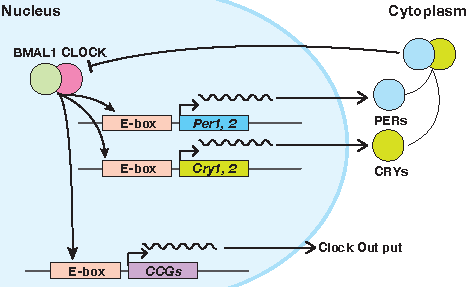Published by Deane Buckley on Jun 16, 2021 8:45:47 AM


Figure: Schematic representation of feedback loop involving CLOCK-BMAL1 complex and CRY and PER proteins involved in creating circadian rhythms.
Tiredness and frustration often mount after long nights in the lab. Why can’t our bodies adjust and allow us to maintain our energy through the night? The answer lies in our circadian rhythms. Circadian rhythms are the daily cycle of biological processes such as wakefulness and metabolism1. Many proteins are involved in regulating our circadian rhythms including CRY proteins. This blog post will catch you up on these proteins and their vital role in regulating circadian rhythms.
- CRY stands for cryptochrome. Cryptochrome proteins are a type of photoreceptor that can transform light into electrical signals in the brain in a process known as phototransduction2.
- There are two major CRY proteins involved in regulation of circadian rhythms: CRY1 and CRY23. CRY proteins interact with two major proteins involved in circadian rhythm regulation: CLOCK and BMAL14.
- A CLOCK protein binds to a BMAL1 protein to form a complex that activates the transcription of proteins involved in regulating metabolism and other biological processes4.
- The CLOCK-BMAL1 complex also transcribes CRY proteins and PER proteins5.
- A CRY protein forms a complex with a PER protein that inhibits the action of the CLOCK and BMAL1 dimer. Thus, the CLOCK-BMAL1 is inhibited from transcribing its downstream proteins.
- The inhibition of CLOCK and BMAL1 also inhibits the transcription of the CRY and PER proteins5.
- The rising and falling levels of these proteins creates a feedback loop of the levels of proteins that are involved in metabolism, wakefulness and other biological processes. Consequently, circadian rhythms are created5.
- In an experiment done by knocking out the CRY genes in mice, it was found that the two proteins are involved in setting the time it takes for a circadian rhythm to elapse. Mice that had the CRY1 gene knocked out had circadian rhythms that were an hour shorter than normal6
MBL International offers a CRY1 antibody, a CRY2 antibody and other products to further your research. With these CRY antibodies there will be no more crying in the lab over frustration with your circadian rhythm research!
- Mouse Polyclonal Anti-CRY1 Antibody
- Mouse Polyclonal Anti-CRY2 Antibody
- Mouse Polyclonal Anti-PER2 Antibody
Citations